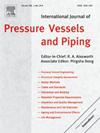含裂纹类缺陷结构FFS的特征断裂韧性评价
IF 3
2区 工程技术
Q2 ENGINEERING, MECHANICAL
International Journal of Pressure Vessels and Piping
Pub Date : 2025-05-26
DOI:10.1016/j.ijpvp.2025.105542
引用次数: 0
摘要
本研究探讨了基于统计方法的探索性应用,以确定断裂韧性的特征值,用于基于最小三个等效(MOTE)方法和传统的威布尔统计断裂韧性数据的适用性(FFS)程序。工作还侧重于主曲线(MC)方法的应用,通过直接评估参考温度,T0和利用一些已建立的CVN - T0相关性来估计下限断裂韧性值。采用典型压力容器钢和超高强度马氏体钢等五种不同类型的结构钢进行断裂韧性测试,提供了MOTE、Weibull统计分析和MC方法所依据的实验数据。总的来说,这些探索性分析表明,虽然Charpy CVN能量和T0之间存在一些相关性,可以在常规评估和工程级应用中用于估计断裂韧性,但它们在预测精度方面也存在一些限制,这是由于材料依赖性及其可变性所造成的。本文章由计算机程序翻译,如有差异,请以英文原文为准。
Evaluation of characteristic fracture toughness for Fitness-for-Service (FFS) assessments of structures containing crack-like flaws
The present study addresses an exploratory application of statistical-based approaches to determine a characteristic value of fracture toughness for use in fitness-for-service (FFS) procedures based on the minimum of three equivalent (MOTE) method and a conventional Weibull statistics to fracture toughness data. The work also focuses on applications of the Master Curve (MC) methodology to estimate lower bound fracture toughness values by direct evaluation of the reference temperature, , and by utilizing some well-established correlations. Fracture toughness tests using five different types of structural steels, including typical pressure vessel steels and an ultrahigh strength martensitic steel, provide the experimental data upon which the MOTE, the Weibull statistical analyses and the MC methodology are conducted. Overall, these exploratory analyses indicate that, while some existing correlations between Charpy CVN energy and can advantageously be used to estimate fracture toughness in routine assessments and engineering-level applications, they also have some limitations in predictive accuracy imposed by material dependency and their variability.
求助全文
通过发布文献求助,成功后即可免费获取论文全文。
去求助
来源期刊
CiteScore
5.30
自引率
13.30%
发文量
208
审稿时长
17 months
期刊介绍:
Pressure vessel engineering technology is of importance in many branches of industry. This journal publishes the latest research results and related information on all its associated aspects, with particular emphasis on the structural integrity assessment, maintenance and life extension of pressurised process engineering plants.
The anticipated coverage of the International Journal of Pressure Vessels and Piping ranges from simple mass-produced pressure vessels to large custom-built vessels and tanks. Pressure vessels technology is a developing field, and contributions on the following topics will therefore be welcome:
• Pressure vessel engineering
• Structural integrity assessment
• Design methods
• Codes and standards
• Fabrication and welding
• Materials properties requirements
• Inspection and quality management
• Maintenance and life extension
• Ageing and environmental effects
• Life management
Of particular importance are papers covering aspects of significant practical application which could lead to major improvements in economy, reliability and useful life. While most accepted papers represent the results of original applied research, critical reviews of topical interest by world-leading experts will also appear from time to time.
International Journal of Pressure Vessels and Piping is indispensable reading for engineering professionals involved in the energy, petrochemicals, process plant, transport, aerospace and related industries; for manufacturers of pressure vessels and ancillary equipment; and for academics pursuing research in these areas.

 求助内容:
求助内容: 应助结果提醒方式:
应助结果提醒方式:


